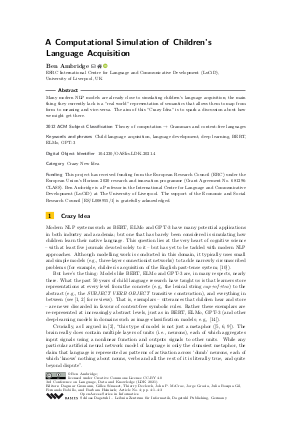A Computational Simulation of Children’s Language Acquisition (Crazy New Idea)
Author
Ben Ambridge 
-
Part of:
Volume:
3rd Conference on Language, Data and Knowledge (LDK 2021)
Part of: Series: Open Access Series in Informatics (OASIcs)
Part of: Conference: Conference on Language, Data and Knowledge (LDK) - License:
 Creative Commons Attribution 4.0 International license
Creative Commons Attribution 4.0 International license
- Publication Date: 2021-08-30
File

PDF
OASIcs.LDK.2021.4.pdf
- Filesize: 384 kB
- 3 pages
Document Identifiers
Subject Classification
ACM Subject Classification
- Theory of computation → Grammars and context-free languages
Keywords
- Child language acquisition
- language development
- deep learning
- BERT
- ELMo
- GPT-3
Metrics
- Access Statistics
-
Total Accesses (updated on a weekly basis)
0Document
0Metadata
Abstract
Many modern NLP models are already close to simulating children’s language acquisition; the main thing they currently lack is a "real world" representation of semantics that allows them to map from form to meaning and vice-versa. The aim of this "Crazy Idea" is to spark a discussion about how we might get there.
Cite As Get BibTex
Ben Ambridge. A Computational Simulation of Children’s Language Acquisition (Crazy New Idea). In 3rd Conference on Language, Data and Knowledge (LDK 2021). Open Access Series in Informatics (OASIcs), Volume 93, pp. 4:1-4:3, Schloss Dagstuhl – Leibniz-Zentrum für Informatik (2021)
https://doi.org/10.4230/OASIcs.LDK.2021.4
BibTex
@InProceedings{ambridge:OASIcs.LDK.2021.4,
author = {Ambridge, Ben},
title = {{A Computational Simulation of Children’s Language Acquisition}},
booktitle = {3rd Conference on Language, Data and Knowledge (LDK 2021)},
pages = {4:1--4:3},
series = {Open Access Series in Informatics (OASIcs)},
ISBN = {978-3-95977-199-3},
ISSN = {2190-6807},
year = {2021},
volume = {93},
editor = {Gromann, Dagmar and S\'{e}rasset, Gilles and Declerck, Thierry and McCrae, John P. and Gracia, Jorge and Bosque-Gil, Julia and Bobillo, Fernando and Heinisch, Barbara},
publisher = {Schloss Dagstuhl -- Leibniz-Zentrum f{\"u}r Informatik},
address = {Dagstuhl, Germany},
URL = {https://drops.dagstuhl.de/entities/document/10.4230/OASIcs.LDK.2021.4},
URN = {urn:nbn:de:0030-drops-145402},
doi = {10.4230/OASIcs.LDK.2021.4},
annote = {Keywords: Child language acquisition, language development, deep learning, BERT, ELMo, GPT-3}
}
Author Details
Funding
This project has received funding from the European Research Council (ERC) under the European Union’s Horizon 2020 research and innovation programme (Grant Agreement No. 681296: CLASS). Ben Ambridge is a Professor in the International Centre for Language and Communicative Development (LuCiD) at The University of Liverpool. The support of the Economic and Social Research Council [ES/L008955/1] is gratefully acknowledged.
References
-
Ben Ambridge. Against stored abstractions: A radical exemplar model of language acquisition. First Language, 40(5-6):509-559, 2020a.

-
Ben Ambridge. Abstractions made of exemplars or "you’re all right, and i’ve changed my mind": Response to commentators. First Language, 40(5-6):640-659, 2020b.

-
Emily M Bender and Alexander Koller. Climbing towards nlu: On meaning, form, and understanding in the age of data. In Proceedings of the 58th Annual Meeting of the Association for Computational Linguistics, pages 5185-5198, 2020.

-
Thea Cameron-Faulkner, Elena Lieven, and Michael Tomasello. A construction based analysis of child directed speech. Cognitive Science, 27(6):843-873, 2003.

-
Daniel C Dennett. From bacteria to Bach and back: The evolution of minds. WW Norton & Company, 2017.

-
Uri Hasson, Samuel A Nastase, and Ariel Goldstein. Direct fit to nature: An evolutionary perspective on biological and artificial neural networks. Neuron, 105(3):416-434, 2020.

-
Dermot Lynott, Louise Connell, Marc Brysbaert, James Brand, and James Carney. The lancaster sensorimotor norms: multidimensional measures of perceptual and action strength for 40,000 english words. Behavior Research Methods, pages 1-21, 2019.

-
Jean M Mandler. How to build a baby: Ii. conceptual primitives. Psychological Review, 99(4):587, 1992.

-
Andrea E Martin. A compositional neural architecture for language. Journal of Cognitive Neuroscience, 32(8):1407-1427, 2020.

-
James L McClelland, David E Rumelhart, PDP Research Group, et al. Parallel distributed processing, volume 2. MIT press Cambridge, MA, 1986.

- William Merrill, Yoav Goldberg, Roy Schwartz, and Noah A. Smith. Provable limitations of acquiring meaning from ungrounded form: What will future language models understand? CoRR, abs/2104.10809, 2021. URL: http://arxiv.org/abs/2104.10809.
- Mitja Nikolaus and Abdellah Fourtassi. Evaluating the acquisition of semantic knowledge from cross-situational learning in artificial neural networks, May 2021. URL: https://doi.org/10.31234/osf.io/mbesf.
- Kexin Yi, Jiajun Wu, Chuang Gan, Antonio Torralba, Pushmeet Kohli, and Joshua B Tenenbaum. Neural-symbolic vqa: Disentangling reasoning from vision and language understanding. arXiv preprint, 2018. URL: http://arxiv.org/abs/1810.02338.
- Chiyuan Zhang, Samy Bengio, Moritz Hardt, Benjamin Recht, and Oriol Vinyals. Understanding deep learning requires rethinking generalization, 2017. URL: http://arxiv.org/abs/1611.03530.
